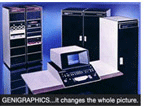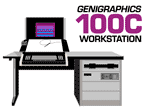 In the decades before the words “home,” “desktop” or “personal” were ever used in conjunction with the word “computer,” one company dominated computer graphics. No, it wasn't Apple, Adobe, or Microsoft – those companies were barely born. While the name may not yet be familiar, you may already know them; because a large part of the user experience of creating graphics using computers today – and the computer business itself – comes from or was influenced by the original Genigraphics Corporation.
In the decades before the words “home,” “desktop” or “personal” were ever used in conjunction with the word “computer,” one company dominated computer graphics. No, it wasn't Apple, Adobe, or Microsoft – those companies were barely born. While the name may not yet be familiar, you may already know them; because a large part of the user experience of creating graphics using computers today – and the computer business itself – comes from or was influenced by the original Genigraphics Corporation.
Throughout most of the 1970s and 1980s, Genigraphics film recorders practically defined digital computer-to-film imaging; while artwork created on Genigraphics equipment helped define early computer graphics. The distinctive Genigraphics' visual style – the classic 3-D bar and pie charts, perspective grids, graduated blue backgrounds, "Space Odyssey" star fields, and multi-colored zoomed headlines have since become part of our collective visual lexicon. (Think 1982’s “Tron" – parts of which were imaged on Genigraphics digital film recorders.)
 Founded in 1973 as a division of General Electric, the Genigraphics Corporation was an international business graphics firm which specialized in the production of computer generated slides, prints and transparencies. They also manufactured the large-desk-sized computer workstations and imaging systems that made the graphics possible. The core technologies that enabled the Genigraphics systems had their origins within the U.S. Military and NASA. As these technologies became available to the public sector Genigraphics utilized them to help create not just a new way of doing things, or a new company, but a new business model, culture and art form.
Founded in 1973 as a division of General Electric, the Genigraphics Corporation was an international business graphics firm which specialized in the production of computer generated slides, prints and transparencies. They also manufactured the large-desk-sized computer workstations and imaging systems that made the graphics possible. The core technologies that enabled the Genigraphics systems had their origins within the U.S. Military and NASA. As these technologies became available to the public sector Genigraphics utilized them to help create not just a new way of doing things, or a new company, but a new business model, culture and art form.
 The Genigraphics Corporation had two key divisions: Equipment Sales, and the Genigraphics Network of Service Bureaus. The Equipment division engineered, manufactured, sold and leased their large Star-Trek-style workstations and film recorders – along with the proprietary software that ran them. The Genigraphics Network of Service Bureaus was the company's prestigious chain of graphic arts production centers which made money from both the production and sales of business graphics and presentations created exclusively with Genigraphics workstations, film recorders, peripherals, and supplies.
The Genigraphics Corporation had two key divisions: Equipment Sales, and the Genigraphics Network of Service Bureaus. The Equipment division engineered, manufactured, sold and leased their large Star-Trek-style workstations and film recorders – along with the proprietary software that ran them. The Genigraphics Network of Service Bureaus was the company's prestigious chain of graphic arts production centers which made money from both the production and sales of business graphics and presentations created exclusively with Genigraphics workstations, film recorders, peripherals, and supplies.
 The business graphics slides that Genigraphics created were frequently enhanced with glows and other effects done by in-house Forox cameras and operators. Complex multiple exposures were also fairly common - which was a method of expanding the strict 256-color-per-graphic limitations of the system. The slide presentations that Genigraphics produced for major clients often involved racks of matched Kodak slide projectors synced together, glass Wess mounts with soft edge masking, music, film, and live performance. As far as slide shows go, these were early multi-media extravaganzas.
The business graphics slides that Genigraphics created were frequently enhanced with glows and other effects done by in-house Forox cameras and operators. Complex multiple exposures were also fairly common - which was a method of expanding the strict 256-color-per-graphic limitations of the system. The slide presentations that Genigraphics produced for major clients often involved racks of matched Kodak slide projectors synced together, glass Wess mounts with soft edge masking, music, film, and live performance. As far as slide shows go, these were early multi-media extravaganzas.
 During the company’s peak years in the mid-1980s, the then-independent Genigraphics Corporation was earning over $25 million in annual revenues. Their Network of Service Bureaus had branches in 24 major cities throughout the world and were producing graphics and slides for nearly every Fortune 500 company, including colleges, universities, ad agencies, the arts, publishing, film and video, as well as for all branches of the United States Government, especially the Military. Equipment Sales were also booming, as clients set up their own in-house Genigraphics slide departments, and local entrepreneurs leased workstations to start their own graphics production facilities.
During the company’s peak years in the mid-1980s, the then-independent Genigraphics Corporation was earning over $25 million in annual revenues. Their Network of Service Bureaus had branches in 24 major cities throughout the world and were producing graphics and slides for nearly every Fortune 500 company, including colleges, universities, ad agencies, the arts, publishing, film and video, as well as for all branches of the United States Government, especially the Military. Equipment Sales were also booming, as clients set up their own in-house Genigraphics slide departments, and local entrepreneurs leased workstations to start their own graphics production facilities.
 But by the end of the 1980s the fortunes and influence of the Genigraphics Corporation were on the decline as the business world began moving away from large expensive proprietary workstations to the new smaller "desktop" computers with off-the-shelf software. In an attempt to remain relevant, Genigraphics briefly marketed their own slide-making application for the IBM PC, dubbed the "Series 1000." Unfortunately the product proved to be a classic case of "too little, too late." Even their new smaller “desktop-sized” sysems, the Genigraphics 100C and 100D workstations, couldn’t stem the tide. By 1988 the company was broken up as the Equipment Sales division was sold off, leaving only their graphics business, in what remained of their global network of Service Bureaus.
But by the end of the 1980s the fortunes and influence of the Genigraphics Corporation were on the decline as the business world began moving away from large expensive proprietary workstations to the new smaller "desktop" computers with off-the-shelf software. In an attempt to remain relevant, Genigraphics briefly marketed their own slide-making application for the IBM PC, dubbed the "Series 1000." Unfortunately the product proved to be a classic case of "too little, too late." Even their new smaller “desktop-sized” sysems, the Genigraphics 100C and 100D workstations, couldn’t stem the tide. By 1988 the company was broken up as the Equipment Sales division was sold off, leaving only their graphics business, in what remained of their global network of Service Bureaus.
Even then, the Genigraphics brand was so respected that a newer, much smaller software company named Microsoft hired them to develop and expand their newest acquisition, a fledgling Mac-only, black and white business graphics application called PowerPoint. Microsoft’s decision to align themselves with the old-guard leader made perfect business sense for them and for the future prospects of their new software program. To the ailing Genigraphics Corporation, the PowerPoint opportunity was both a last shot at survival and their chance to cement their legacy for the ages.
 Using their own software as the model, Genigraphics basically re-made PowerPoint in their own image – incorporating much of the look and feel, tools, fonts, menus, language and interface of the Genigraphics system into the application. Genigraphics supplied nearly everything; the original PowerPoint background masters, the original PowerPoint color schemes, the original PowerPoint slide templates, the original clip art library – even the program's VGA-friendly, 256 color palette was based upon the Genigraphics system's 256 color palette.
Using their own software as the model, Genigraphics basically re-made PowerPoint in their own image – incorporating much of the look and feel, tools, fonts, menus, language and interface of the Genigraphics system into the application. Genigraphics supplied nearly everything; the original PowerPoint background masters, the original PowerPoint color schemes, the original PowerPoint slide templates, the original clip art library – even the program's VGA-friendly, 256 color palette was based upon the Genigraphics system's 256 color palette.
In 1988, the first product of the Microsoft-Genigraphics alliance PowerPoint 2.0, was released. At that time Genigraphics' involvement was limited to a slide imaging offer. On the box it read: "New! Fast interface to Genigraphics professional slide production service centers." The package included a Genigraphics Driver and "GraphicsLink" software, which enabled users to "pack" and send their now-full color PowerPoint presentations to a Genigraphics Service Bureau via a primative modem (probably at 9.6 baud rate). Once there, they were ripped with special software and imaged on film using a Genigraphics 2000-line film recorder. The finished slides were then promptly mounted and shipped to the customer.
The full Genigraphics collaboration, PowerPoint 3.0, was released for both Mac and PC in 1992. It was marketed as both a standalone product and as part of Office 3.0, the first edition of Microsoft’s new software sales strategy. Office was a “suite” of business productivity applications which combined Powerpoint, the new “Microsoft Clip Art Library,” along with two other recent Microsoft acquisitions, Word and Excel. The rest is history.
 The original Microsoft Clip Art Library – their still evolving collection of symbols, drawings and maps – was originally based solely upon and licensed from The Genigraphics Reference Guide, the Corporation's extensive in-house collection of visual images. The sometimes-quirky digital drawings and symbols in the "Reference Guide" had been complied from years of work by Genigraphics’ own artists (they called them “operators”) and may possibly be the world's first digital clip art library. Artists were encouraged to work on their own ideas in their "down time" between assignments and occasionally these more-offbeat creations became part of the corporate library. The structure and the content of The Genigraphics Reference Guide (and the later-Microsoft version) has influenced clip art libraries since its release. How many times and how many ways have you seen that "Two Hands Shaking" image? (shown above right). The original version came from Genigraphics.
The original Microsoft Clip Art Library – their still evolving collection of symbols, drawings and maps – was originally based solely upon and licensed from The Genigraphics Reference Guide, the Corporation's extensive in-house collection of visual images. The sometimes-quirky digital drawings and symbols in the "Reference Guide" had been complied from years of work by Genigraphics’ own artists (they called them “operators”) and may possibly be the world's first digital clip art library. Artists were encouraged to work on their own ideas in their "down time" between assignments and occasionally these more-offbeat creations became part of the corporate library. The structure and the content of The Genigraphics Reference Guide (and the later-Microsoft version) has influenced clip art libraries since its release. How many times and how many ways have you seen that "Two Hands Shaking" image? (shown above right). The original version came from Genigraphics.
Almost ten years later, the last versions of Powerpoint and Microsoft Office to include any mention of the Genigraphics Corporation was PowerPoint 2001 and Office 2001 for Windows (which was available until Office 2003 came out), and PowerPoint 98 for Mac and Office 98 (which was sold until Office X for Mac came out in 2001). Up until that point, credits to Genigraphics and other company information had been prominently featured both on the box and within the application's "About this Program" text. Also removed was the Genigraphics Driver and "Graphics Link" software.
 By the mid-1990s, as Microsoft was becoming one of the richest companies in the world, the original, once-cutting-edge, high-flying Genigraphics Network of Service Bureaus was broken up and dissolved. Their remaining hardware and software assets were purchased by In Focus Systems, a company known for their portable digital projectors, which are ironically marketed for use with Powerpoint presentations. As a remnant of the old network, In Focus Systems’ PowerPoint slide imaging and poster business is still in operation today. (This educational alumni site is not affiliated in any way with the new company.)
By the mid-1990s, as Microsoft was becoming one of the richest companies in the world, the original, once-cutting-edge, high-flying Genigraphics Network of Service Bureaus was broken up and dissolved. Their remaining hardware and software assets were purchased by In Focus Systems, a company known for their portable digital projectors, which are ironically marketed for use with Powerpoint presentations. As a remnant of the old network, In Focus Systems’ PowerPoint slide imaging and poster business is still in operation today. (This educational alumni site is not affiliated in any way with the new company.)
In the end, with a successful run of over 20 years, the original Genigraphics Corporation's seminal contributions to today’s mainstream digital culture are barely known. While early works from the dawn of photography, motion pictures, and popular music often qualify for scholarly studies, preservation and museum exhibitions - the creative output of the original Genigraphics and its artist “operators” has sadly been relegated to the dustbin of history. The Genigraphics Art Society hopes to revive that legacy.
 The 1970s and 1980s were a pivotal time in our collective cultural history. Innovative companies like Genigraphics reaped the benefits of the burgeoning creative partnership between high technology and the arts. At that time there were no computer graphics' how-to books, no 1-800 support hotlines, no computer magazines, and no websites. The dedicated graphic artists, engineers, programmers, account executives, and sales reps of the original Genigraphics Corporation defined the first generation of digital artists – and computer graphics itself, by the seat of their pants. Their hard work, determination and enthusiasm helped forge a new industry, a new culture, and a new art form.
The 1970s and 1980s were a pivotal time in our collective cultural history. Innovative companies like Genigraphics reaped the benefits of the burgeoning creative partnership between high technology and the arts. At that time there were no computer graphics' how-to books, no 1-800 support hotlines, no computer magazines, and no websites. The dedicated graphic artists, engineers, programmers, account executives, and sales reps of the original Genigraphics Corporation defined the first generation of digital artists – and computer graphics itself, by the seat of their pants. Their hard work, determination and enthusiasm helped forge a new industry, a new culture, and a new art form.
Ever wondered why we still call them “slides?” Ask the Genigraphics Corporation.